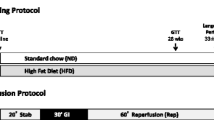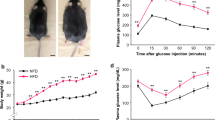Abstract
Purpose
By increasing circulating free fatty acids and the rate of fatty acid oxidation, obesity decreases glucose oxidation and myocardial tolerance to ischemia. Partial inhibition of fatty acid oxidation may improve myocardial tolerance to ischemia/reperfusion (I/R) in obesity. We assessed the effects of oxfenicine treatment on post ischemic cardiac function and myocardial infarct size in obese rats.
Methods
Male Wistar rats were fed a control diet or a high calorie diet which resulted in diet induced obesity (DIO) for 16 weeks. Oxfenicine (200 mg/kg/day) was administered to control and DIO rats for the last 8 weeks. Isolated hearts were perfused and infarct size and post ischemic cardiac function was assessed after regional or global ischemia and reperfusion. Cardiac mitochondrial function was assessed and myocardial expression and activity of CPT-1 (carnitine palmitoyl transferase-1) and IRS-1 (insulin receptor substrate-1) was assessed using Western blot analysis.
Results
In the DIO rats, chronic oxfenicine treatment improved post ischemic cardiac function and reduced myocardial infarct size after I/R but had no effect on the cardiac mitochondrial respiration. Chronic oxfenicine treatment worsened post ischemic cardiac function, myocardial infarct size and basal mitochondrial respiration in control rat hearts. Basal respiratory control index (RCI) values, state 2 and state 4 respiration rates and ADP phosphorylation rates were compromised by oxfenicine treatment.
Conclusion
Chronic oxfenicine treatment improved myocardial tolerance to I/R in the obese rat hearts but decreased myocardial tolerance to I/R in control rat hearts. This decreased tolerance to ischemia of oxfenicine treated controls was associated with adverse changes in basal and reoxygenation mitochondrial function. These changes were absent in oxfenicine treated hearts from obese rats.








Similar content being viewed by others
References
Mathieu P, Pibarot P, Larose E, Poirier P, Marette A, Despés JP. Visceral obesity and the heart. Int J Biochem Cell Biol. 2008;40:821–36.
Poirier P, Giles TD, Bray GA, Hong Y, Stern JS, Pi-Sunyer FX, et al. Obesity and cardiovascular disease: pathophysiology, evaluation and effect of weight loss: an update of the 1997 American Heart Association scientific statement on obesity and heart disease from the obesity committee of the council on nutrition, physical activity and metabolism. Circulation. 2006;113:898–918.
Diniz YS, Burneiko RM, Seiva FRF, Almeida FQA, Galhardi CM, Filho JL. Diet compounds, glycemic index and obesity-related cardiac effects. Int J Cardiol. 2008;124:92–9.
Kobayashi H, Nakamura T, Miyaoka K, Nishida M, Funahashi T, Yamashita S, et al. Visceral fat accumulation contributes to insulin resistance, small sized low-density lipoprotein and progression of coronary artery disease in middle-aged non-obese Japanese men. Jpn Circ J. 2001;65:193–9.
Thim T, Bentzon JF, Kristiansen SB, Simonsen U, Anderson HL, Wassermann K, et al. Size of myocardial infarction induced by ischemia/reperfusion is unaltered in rats with metabolic syndrome. Clin Sci. 2006;110:665–71.
Hegarty BD, Turner N, Cooney GJ, Kraegen EW. Insulin resistance and fuel homeostasis: the role of AMP-activated protein kinase. Acta Physiol. 2009;196:129–45.
Lopaschuk GD, Ussher JR, Folmes CL, Jaswal JS, Stanley WC. Myocardial fatty acid metabolism in health and disease. Physiol Rev. 2010;90:207–58.
Lopaschuk GD, Folmes CD, Stanley WC. Cardiac energy metabolism in obesity. Circ Res. 2007;101:335–47.
Carley AN, Severson DL. Fatty acid metabolism is enhanced in type 2 diabetic hearts. Biochim ET Biophys Acta. 2005;1734:112–26.
Opie LH. The heart: physiology and metabolism, second edition Raven Press 1991.
Calvani M, Reda E, Arrigoni-Martelli E. Regulation of carnitine of myocardial fatty acid and carbohydrate metabolism under normal and pathological conditions. Basic Res Cardiol. 2000;95:2.
Stanley WC, Lopaschuk GD, McCormack JG. Regulation of energy substrate metabolism in the diabetic heart. Cardiovasc Research. 1997;34:25–33.
Rupp H, Rupp TP, Maisch B. Fatty acid oxidation inhibition with PPAR-α activation (FOXIB/PPARα) for normalizing gene expression in heart failure? Cardiovasc Research. 2005;66:423–6.
Taegtmeyer H, Wilson CR, Razeghi P, Sharma S. Metabolic energetics and genetics in the heart. Ann New York Acad Sci. 2005;1047:208–18.
Hafstad AD, Khalid AM, How OJ, Larsen TS, Aasum E. Glucose and insulin improve cardiac efficiency and post-ischemic functional recovery in perfused hearts from type 2 diabetic (db/db) mice. Am J Physiol Endorinol Metab. 2007;292:E1288–94.
Rupp H, Zarain-Herzberg A, Maisch B. The use of partial fatty acid oxidation inhibitors for metabolic therapy of angina pectoris and heart failure. Urban Vogel. 2002;27:621–36.
Beadle RM, Frenneaux M. Modification of myocardial substrate utilisation: a new therapeutic paradigm in cardiovascular disease. Heart. 2010;96:824–30.
Opie LH, Knuuti J. The adrenergic-fatty acid load in heart failure. J Am Coll Cardiol. 2009;54:1637–46.
Stephens TW, Higgins AJ, Cook GA, Harris RA. Two mechanisms produce tissue-specific inhibition of fatty acid oxidation by oxfenicine. Biochem J. 1985;227:651–60.
Burges RA, Gardiner DG, Higgins AJ. Protection of the ischemic dog heart by oxfenicine. Life Sci. 1981;29:1847–85.
Stanley WC. Partial fatty acid oxidation inhibitors for stable angina. Expert Opin Investig Drugs. 2002;11:615–29.
Okere IC, Chandler MP, McElfresh TA, Rennison JH, Kung TA, Hoit BD, et al. Carnitine palmitoyl transferase-I inhibition is not associated with cardiac hypertrophy in rats fed a high – fat diet. Clin Exp Pharmacol Physiol. 2007;34:113–9.
Bachmann E, Weber E. Biochemical mechanisms of oxfenicine cardio toxicity. Pharmacol. 1988;36:238–48.
Jodalen H, Ytrehus K, Moen P, Hokland B, Mjøs OD. Oxfenicine-induced accumulation of lipid in the rat myocardium. J Mol Cell Cardiol. 1988;20:277–82.
Greaves P, Martin J, Michel MC, Mompon P. Cardiac hypertrophy in the dog and rat induced by oxfenicine, an agent which modifies muscle metabolism. Arch Toxicol. 1984;7:488–93.
Chang KC, Tseng CD, Lu SC, Liang JT, Wu MS, Tsai MS, et al. Effects of acetyl-L-carnitine and oxfenicine on aorta stiffness in diabetic rats. Eur J Clin Invest. 2010;40:1–9.
Chavez PN, Stanley WC, McElfresh TA, Huang H, Sterk JP, Chandler ME. Effect of hyperglycemia and fatty acid oxidation inhibition during aerobic conditions and demand-induced ischemia. Am J Physiol Heart Circ Physiol. 2003;284:H1521–7.
Chandler MP, Chavez PN, McElfresh TA, Huang H, Harmon CS, Stanley WC. Partial inhibition of fatty acid oxidation increases regional contractile power and efficiency during demand-induced ischemia. Cardiovasc Research. 2003;59:143–51.
Lionetti V, Linke A, Chandler MP, Young ME, Penn MS, Gupte S, et al. Carnitine palmitoyl transferase-I inhibition prevents ventricular remodelling and delays decompensation in pacing-induced heart failure. Cardiovasc Research. 2005;66:454–61.
Pickavance LC, Tadayyon M, Widdowson PS, Buckingham RE, Wilding JPH. Therapeutic index for rosiglitazone in dietary obese rats: separation of efficacy and haemodilution. Brit J Pharmacol. 1999;128:1570–6.
Du Toit EF, Smith W, Muller C, Strijdom H, Stouthammer B, Woodiwiss AJ, et al. Myocardial susceptibility to ischemic-reperfusion injury in a pre-diabetic model of dietary-induced obesity. Am J Physiol Heart Circ Physiol. 2008;294:H2336–43.
Lindenmayer GE, Sordahl LA, Schwartz A. Re-evaluation of oxidative phosphorylation in cardiac mitochondria from normal animals and animals in heart failure. Circ Res. 1968;23:439–50.
Lanza IR, Nair KS. Functional assessment of isolated mitochondria in vitro. Methods Enzymol. 2009;457:349–72.
Lowry OH, Rosebrough NJ, Farr AL, Randall RJ. Protein measurement with the folin phenol reagent. J Biol Chem. 1951;193:265–75.
Bradford MM. A rapid sensitive method for quantification of microgram quantities of protein utilizing the principle of protein-dye binding. Anal Biochem. 1976;71:248–54.
Higgins AJ, Morville M, Burges RA. Oxfenicine diverts rat muscle metabolism from fatty acid to carbohydrate oxidation and protects the ischemic rat heart. Life Sci. 1980;27:963–70.
Higgins AJ, Morville M, Burges RA. Mechanism of action of oxfenicine on muscle metabolism. Biochem Biophys Res Comm. 1981;100:291–6.
Molaparast-Sales F, Liedtke AJ, Nellis SH. Effects of the fatty acid blocking agents, oxfenicine and 4-bromocrotonic acid, on performance in aerobic and ischemic myocardium. J Mol Cell Cardiol. 1987;19:509–20.
Essop MF, Chan WYA, Valle A, García-Palmer FJ, Du Toit EF. Impaired contractile function and mitochondrial respiratory capacity in response to oxygen deprivation in a rat model of pre-diabetes. Acta Physiol. 2009;197:289–96.
Zhou L, Huang H, Yuan CL, Keung W, Lopaschuk GD, Stanley WC. Metabolic response to an acute jump in cardiac workload: effects on malonyl-CoA, mechanical efficiency, and fatty acid oxidation. Am J Physiol Heart Circ Physiol. 2008;294:H954–60.
Broderick TL, Glick B. Effect of gender and fatty acids on ischemic recovery of contractile and pump function in the rat heart. Gend Med. 2004;1:86–99.
Carregal M, Varela A, Dalamon V, Sacks S, Savino EA. Beneficial effects of oxfenicine on the hypoxic rat atria. Arch Physiol Biochem. 1995;103:45–9.
Prendes MGM, Garcia JV, Testoni G, Fernandez MA, Perazzo JC, Savino EA, et al. Influence of fasting on the effects of dimethylamiloride and oxfenicine on ischemic–reperfused rat hearts. Arch Physiol Biochem. 2006;112:31–6.
Randle PJ, Garland PB, Hales CN, Newsholme EA. The glucose fatty-acid cycle. Its role in insulin sensitivity and the metabolic disturbances of diabetes mellitus. Lancet. 1963;1:785–9.
Randle PJ. Regulatory interactions between lipids and carbohydrates: the glucose fatty acid cycle after 35 years. Diabet Metab. 1998;14:263–83.
Guo L, Tabrizchi R. Peroxisome proliferator-activated receptor gamma as a drug target in the pathogenesis of insulin resistance. Pharmacol Therap. 2006;111:147–73.
King KL, Opie LH. Glucose and glycogen utilization in myocardial ischemia-changes in metabolism and consequences for the myocyte. Mol Cell Biochem. 1998;180:3–26.
Apstein CS, Opie LH. Glucose-insulin-potassium (GIK) for acute myocardial infarction: a negative study with a positive value. Cardiovasc Drugs Ther. 1999;13:185–9.
Bergmann SR, Weinheimer CJ, Markham J, Herrero P. Quantitation of myocardial fatty acid metabolism using PET. J Nucl Med. 1996;37:1723–30.
Drake-Holland AJ, Passingham JE. The effect of oxfenicine on cardiac carbohydrate metabolism is intact dogs. Bas Res Cardiol. 1983;78:19–27.
Barr RL, Lopaschuk GD. Direct measurement of energy metabolism in the isolated working rat heart. JPM. 1997;38:11–7.
Lochner A, Du Toit EF, Huisamen B, Koeslag JH, Moolman JA. Cellular injury in ischemia. Cardiovasc Journ of South Africa. 2004;15:205–6.
Taegtmeyer H. Metabolism — the lost child of cardiology. J Am Coll Cardiol. 2000;36:1386–8.
Lee L, Campbell R, Scheuermann-Freestone M, Taylor R, Gunaruwan P, Williams L, et al. Metabolic modulation with perhexiline in chronic heart failure a randomized, controlled trial of short-term use of a novel treatment. Circ Res. 2005;112:3280–8.
Aasum E, Khalid AM, Gudbrandsen OA, How OJ, Berge RK, Larsen TS. Fenofibrate modulates cardiac and hepatic metabolism and increases ischemic tolerance in diet-induced obese mice. J Mol Cell Cardiol. 2008;44:201–9.
Belke DD, Larsen TS, Gibbs EM, Severson DL. Altered metabolism causes cardiac dysfunction in perfused hearts from diabetic (db/db) mice. Am J Physiol Endocrinol Metab. 2000;279:E1104–13.
Hue L, Taegtmeyer H. The Randle cycle revisited: a new head for an old hat. Am J Physiol Endocrinol Metab. 2009;297:E578–91.
Dyck JRB, Cheng JF, Stanley WC, Barr R, Chandler MP, Brown S, et al. Malonyl-Coenzyme A decarboxylase inhibition protects the ischemic heart by inhibiting fatty acid oxidation and stimulating glucose oxidation. Circ Res. 2004;94:e78–84.
Liu Q, Docherty JC, Rendell JCT, Clanachan AS, Lopaschuk GD. High levels of fatty acids delay the recovery of intracellular pH and cardiac efficiency in post-ischemic hearts by inhibiting glucose oxidation. J Am Coll Cardiol. 2002;39:718–25.
Kantor PF, Lucien A, Kozak R, Lopaschuk GD. The anti angina drug trimetazidine shifts cardiac energy metabolism from fatty acid oxidation to glucose oxidation inhibiting mitochondrial long chain 3-Ketoacyl Coenzyme A Thiolase. Circ Res. 2000;86:580–8.
Bielefeld DR, Vary TC, Neely JR. Inhibition of Carnitine Palmitoyl-CoA Transferase activity and fatty acid oxidation by lactate and oxfenicine in cardiac muscle. Mol Cell Cardiol. 1985;17:619–25.
Acknowledgments
This study was financially supported by the South African National Research Foundation (Prof. E.F. Du Toit and Dr. E. Marais). We would also like to thank Prof. A. Lochner and Prof. B. Huisamen for expert advice and guidance.
Conflict of interest
None.
Author information
Authors and Affiliations
Corresponding author
Rights and permissions
About this article
Cite this article
Maarman, G., Marais, E., Lochner, A. et al. Effect of Chronic CPT-1 Inhibition on Myocardial Ischemia-Reperfusion Injury (I/R) in a Model of Diet-Induced Obesity. Cardiovasc Drugs Ther 26, 205–216 (2012). https://doi.org/10.1007/s10557-012-6377-1
Published:
Issue Date:
DOI: https://doi.org/10.1007/s10557-012-6377-1




